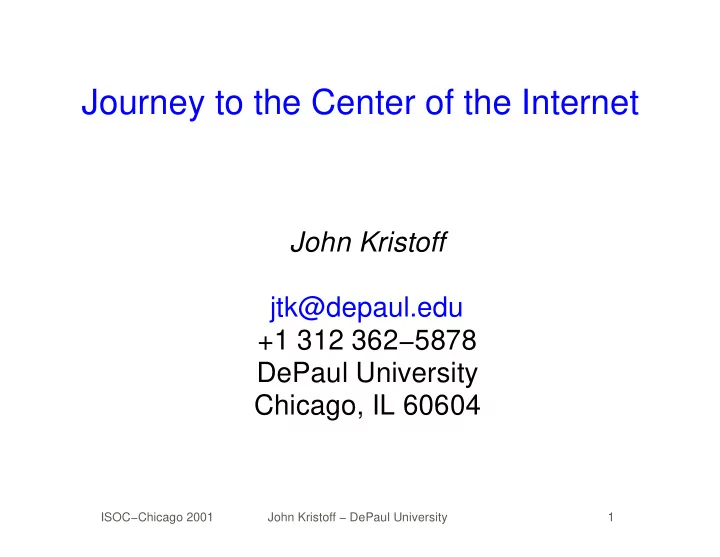

Journey to the Center of the Internet John Kristoff jtk@depaul.edu +1 312 362−5878 DePaul University Chicago, IL 60604 ISOC−Chicago 2001 John Kristoff − DePaul University 1
� � ✁ � ✁ � ✁ ✁ � ✁ Internet as a layered architecture Application layer Web, email Transport layer Reliability, flow control Internet layer Routing, global addressing Link layer Ethernet, PPP Physical layer Wires, radio, optical fiber ISOC−Chicago 2001 John Kristoff − DePaul University 2
� � � � Meet Ms. Dana Paquette She has a high−speed Internet connection She’s browsing the web She just clicked on a web link Let’s watch... ISOC−Chicago 2001 John Kristoff − DePaul University 3
� ✁ � � � � ✁ Take me to www.isoc.org Web site clicked is www.isoc.org IP doesn’t understand names We must convert this to an IP address TCP/IP software to DNS server: "What is the IP address of www.isoc.org?" DNS server replies: "www.isoc.org = 206.131.249.182" ISOC−Chicago 2001 John Kristoff − DePaul University 4
� ✁ � � ✁ ✁ ✁ ✁ Protocol stack, connect()! Create destination TCP/IP packet using: Destination host = 206.131.249.182 Destination application = http (port 80) Fill in source host information Source IP address Source application number Other info (we’ll return to specifics later) Send connection request ISOC−Chicago 2001 John Kristoff − DePaul University 5
TCP/IP sends packet to adapter ISOC−Chicago 2001 John Kristoff − DePaul University 6
✂ ✂ ✂ Ethernet card encapsulates data Could be wireless, FDDI, cable modem, etc. TCP/IP packet goes into payload Ethernet dest. address = gateway router ISOC−Chicago 2001 John Kristoff − DePaul University 7
Out the card, onto the wire... ISOC−Chicago 2001 John Kristoff − DePaul University 8
Bit by bit... ISOC−Chicago 2001 John Kristoff − DePaul University 9
Into the walls and ceilings... ISOC−Chicago 2001 John Kristoff − DePaul University 10
Through the patch panel... ISOC−Chicago 2001 John Kristoff − DePaul University 11
Onto the Ethernet switch... ISOC−Chicago 2001 John Kristoff − DePaul University 12
� � � � � To the campus router... Peels off layer 2 info Router performs lookup for IP dest. Forwards towards destination network Decrements time to live field Re−computes IP checksum ISOC−Chicago 2001 John Kristoff − DePaul University 13
And out the Internet router... ISOC−Chicago 2001 John Kristoff − DePaul University 14
To the Internet towards ISOC.org! ISOC−Chicago 2001 John Kristoff − DePaul University 15
� � � � ✁ ✁ � IP ties everything together IP carries data end−to−end across links Routers examine IP layer information They forward towards the destination Similar to the sorting process of postal service Identifies both a source and destination Unreliable − no guaranteed delivery! Primary role of IP: to move packets around ISOC−Chicago 2001 John Kristoff − DePaul University 16
The IP datagram ISOC−Chicago 2001 John Kristoff − DePaul University 17
� ✁ � ✁ ✁ ✁ ✁ ✁ The case for reliability Sometimes the network is offered more packets than it can handle Can’t queue forever Might prefer to drop packets rather than delay them Sender can easily re−send packets Need a protocol to ensure reliability The case for TCP! Note: reliability is placed in the hands of end−points We’ll come back to this in a minute ISOC−Chicago 2001 John Kristoff − DePaul University 18
� � � Congestion control and avoidance TCP increases transmission rate over time If TCP detects a packet loss it slows down Competing TCPs lead to fairness over time ISOC−Chicago 2001 John Kristoff − DePaul University 19
The TCP segment ISOC−Chicago 2001 John Kristoff − DePaul University 20
The end−to−end picture ISOC−Chicago 2001 John Kristoff − DePaul University 21
Dana to ISOC.org TCP/IP packet ISOC−Chicago 2001 John Kristoff − DePaul University 22
� � � � � End−to−end principle Guiding principle of the Internet architecture Considers where to put intelligence Minimize functions and features within the communcations system Need end−to−end functions anyway Argues against fate−sharing and network statefulness ISOC−Chicago 2001 John Kristoff − DePaul University 23
✁ � � � ✁ ✁ � � Is the Internet broken? E2E is being violated as standard practice Network address translation (NAT) Firewalls Various middleboxes New applications are difficult to deploy IPv6 could shift move back towards E2E Architecture has probably changed forever ...won’t come all the way back ISOC−Chicago 2001 John Kristoff − DePaul University 24
✁ ✁ � ✁ ✁ ✁ � Anything else wrong with the ’net? Security, security and security There will continue to be major issues here Internet is based on trust relationships Host security is hard, net security doesn’t work Routing table growth Not a critical problem, but causing some concern Increase in multi−homing casing table bloat ISOC−Chicago 2001 John Kristoff − DePaul University 25
� � � � ✁ � What’s new and exciting? (or "the I finished too early slide" ) Wireless Interactive applications Voice and games IPv6 DNS High−speed technologies and testbeds ISOC−Chicago 2001 John Kristoff − DePaul University 26
� � � � ✁ ✁ � References http://www.reed.com/Papers/EndtoEnd.html http://www.ietf.org RFC 2775 Internet Transparency RFC 1958 Architectural Principles of the Internet http://www.nanog.org http://networks.depaul.edu http://condor.depaul.edu/~jkristof/ ISOC−Chicago 2001 John Kristoff − DePaul University 27
Recommend
More recommend